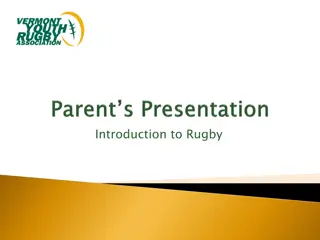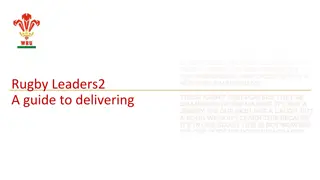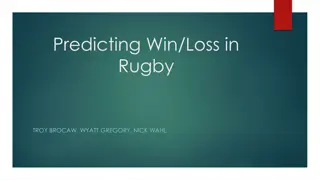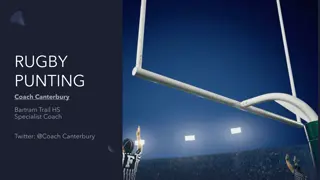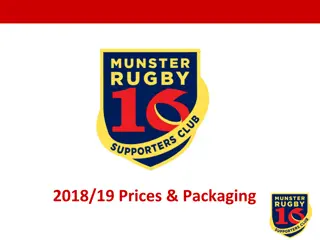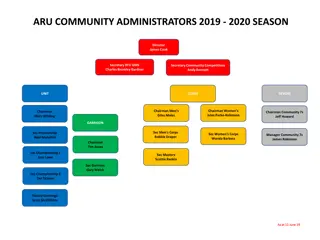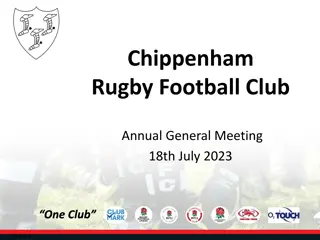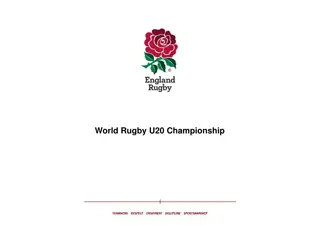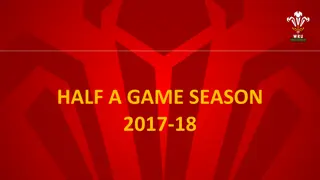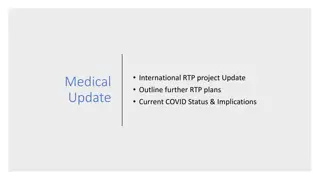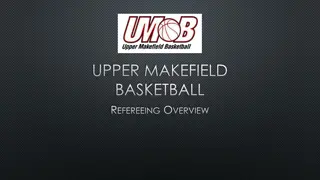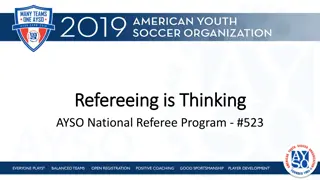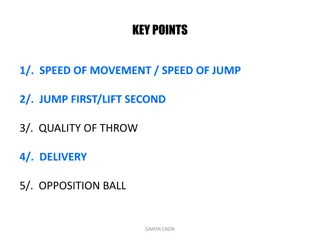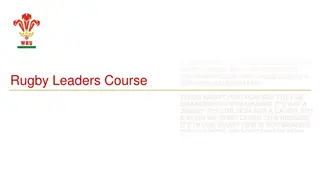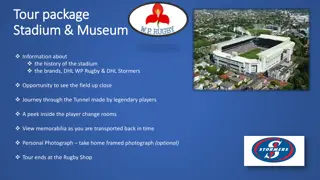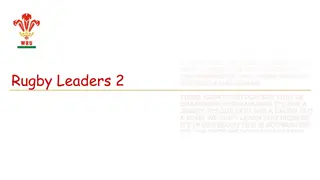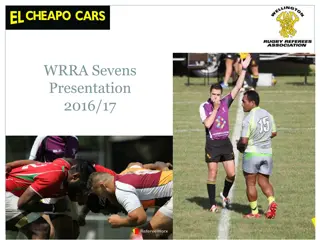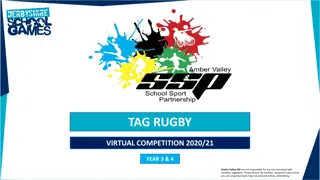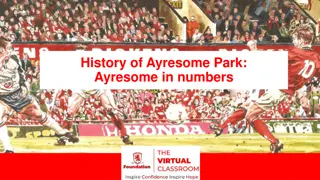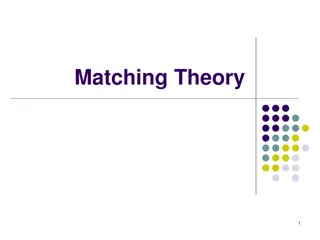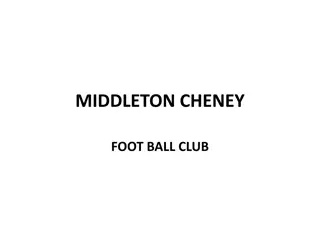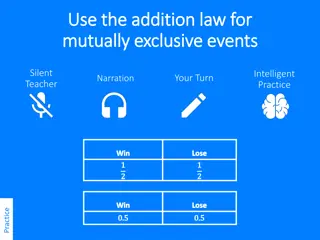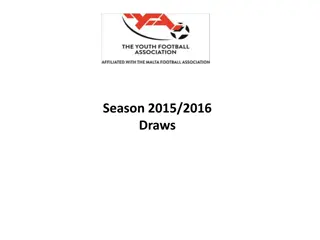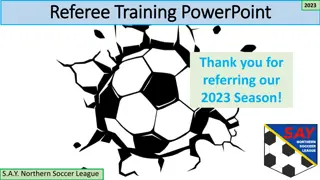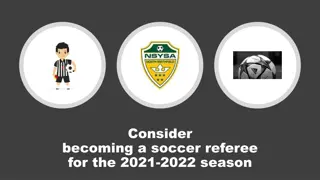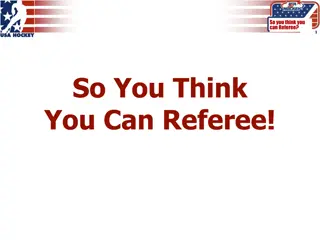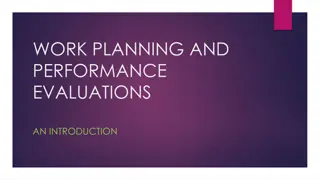Refereeing Performance in Rugby Matches
The discussion delves into the challenges and strategies of refereeing in rugby matches, emphasizing the importance of effective game management. It explores the impact of decision-making, compliance indicators, and creating space for players to attack. Referees are urged to adhere to the ARU Referee Profile for consistent high performance and to facilitate an enjoyable and watchable game. Key points include the timing of management interventions, tackling and offside management, and the nuances of achieving a low penalty count.
Download Presentation

Please find below an Image/Link to download the presentation.
The content on the website is provided AS IS for your information and personal use only. It may not be sold, licensed, or shared on other websites without obtaining consent from the author. Download presentation by click this link. If you encounter any issues during the download, it is possible that the publisher has removed the file from their server.
E N D
Presentation Transcript
Escalation 2017 PART 1
Are you refereeing to the profile? What have I seen around the state? Most think a low penalty count indicates a good refereeing performance To achieve a low penalty count referees are managing almost everything tacklers roll away, tackle assist let him go, last feet, step etc. But what do you get when you manage the tackle and offside? You still get slow ball and no space. You still get a game that is not fun to play in and not good to watch Management does not change behavior!
ARU Referee Profile Decision Making Consistent High Performance Change Behaviour Empathy Timely, robust review and follow up Thorough game plan Personal Attributes
Is there a time to manage in a game? Yes there is! The key to effective management is twofold: You have set up the game so that players are complying ; and You have time and space to do it so it does not have an adverse effect on the game The message here is don t manage early in the match because it never changes behaviour
So what do you have to do to facilitate a game that is good to play in and to watch? Setup the game early, and Referee to the ARU Referee Profile We will deal with the profile first so that we can draw from it what we need to do to set up the game.
Decision Making Contest at the tackle getting it right What are the indicators of non compliance? One team is dominating a breakdown but can t win the ball. This should be a red light in your dashboard. Why is it so?
Decision Making Ensure space for players to attack What are the indicators of non compliance? Players offside at set plays, rucks and mauls Players in front of the kicker moving forward Players inside the ten and not retiring But if you are not seeing any of this but the backs have no time and space and it turns into a forward oriented slogging match you have to find out why there is no space. No space is a red light in your dashboard
Decision Making Good scrum outcomes What are the indicators of non compliance? Not square and steady at the put in Not maintaining binds Boring in, dipping or illegal wheeling What is your definition of a steady scrum? After every call and before the ball is put in, the heads have stopped moving and the feet have stopped moving
Decision Making PK relevance and balance Were the decisions relevant to the game in front of you? Not making 'technically correct' decisions that do not fit the context of the situation Accuracy Low number of errors Low number of non-decisions with meaning IT ALL BOILS DOWN TO ACCURATE APPLICATION OF MATERIAL EFFECT!
Change Behaviour Effective on-field presence Body language Only talk for actions Effective captain management Clarity of messages Timing of messages (what can be achieved without making the referee the centre of attention?)
Change Behaviour Effective timing of interventions Identifying trends early and acting on them What is a trend? 2 or more PK of similar type grouped together by time or location What do you count? Not just PK. Every converted advantage is also counted Who can help? Get your ARs to assist in identifying trends Were YC warnings or YC timely/early/late? Do not compromise standards in pressure situations Who adapted? The referee or the teams?
Empathy Effective working relationships with players and captains Show game awareness and an ability to read play Advantage and Material Effect Identifying when a game is hotting up Demonstrate credibility acceptance by teams of the person and the decisions Ability to perform in a range of environments New teams, new places, conditions, weather
Setting Up The Game There are three areas which, if we can get the message across early to both teams, will help set up the game. They are: Quick Ball Space Good scrum outcomes So how do we do it? Can we use pre match or the Toss to get some messages across?
Getting the message across early You have two opportunities pre match. They are the boot inspection or the coin toss. Both have advantages and disadvantages. You should use them to your benefit to set up the game by getting the message to both teams early about quick ball, space and possibly scrum outcomes This means planning when and where you do both as you need to schedule them so they don t impact on team preparation Your message also needs to be no more than two minutes long
Pre Match (Boot and Clothing Inspection) This is an ideal time to talk about quick ball and space Rather than a list of do s and don ts explain what you are trying to achieve and what you will be looking for eg. Today I am working hard on quick ball at the tackle/ruck. That means I will be looking for tacklers to roll away or get to their feet quickly, tackle assists to release and come through the gate and support players staying on their feet. I will also be working hard on keeping players onside, around the rucks and mauls and further out amongst the outside backs. Note everything is couched in the positive, there are no dont s
So what do you achieve by this short speech? You have put in the minds of the players and captains that these will be focus areas before the game has even started. It means you can, when identifying trends, do everything one step earlier than perhaps you would do if you hadn t briefed the players. Eg. We spoke about this before the game. We have already had two penalties at the tackle which slowed the ball. Fix it!
What about the coin toss as the vehicle for the player brief You can use it instead of the boot inspection. Its advantages are that both Captains know the other has been given an identical message. It starts that referee captain dialogue even before the game starts It can be coupled with the CONTRACT (what is the contract?) The contract is the agreement you have with both captains on how you are going to work together to manage the game between you. Its main disadvantage is that some captains won t tell their players
The difference between change behaviour early of late in the game Change behavior (Yellow Card) early in the game will have less impact on the score and the game will open up early Change behavior implemented too late in the game will have an impact on the score (14 tired players trying to keep out 15 players). It will also mean that all the play before the implementation, was rubbish to watch or play in.
Dont confuse setting up the game with a penalty fest Setting up the game means identifying trends quickly and applying change behavior early. The penalties should stop flowing just as quickly as change behaviour is implemented. A high penalty count indicates a lack of ability to identify trends and change behavior. Penalties early followed by change behavior early bares no resemblance to a penalty fest
So what are the key lessons? Set up the game early Work hard on quick ball, space and good scrum outcomes. If you are not getting any of these early there should be a red light in the middle of your dashboard Identify the trends early and change behavior early Apply material effect appropriately. Only manage when you can ie. After players are complying and managing an infringement will have minimal adverse impact Only play advantage when you can see that the non-infringing team has the time and space and people to do so
ARU Referee Profile Change Behaviour Effective on-field presence Effective captain management (timing and clarity of messages) Effective timing of interventions (warnings, YC) Does not compromise standards in pressure situations Note: There will be instances where you don t actually change behaviour because of the team / player attitudes this is not a referee issue provided you have used the tools in the toolbox
Captain / Referee Interaction Major part of changing behaviour / escalation is captain interaction What does a captain want from the referee? What is the captain thinking during interactions?
Captain Perspective Wants a referee to have full control of the game especially in tight contested games Respect should go both ways Captain inquiry met with not now or ignored, but then referee asks for assistance later? Role that confidence plays
Captain Perspective Captain query re repeated infringements Ref answer I ll look at it , is the ref working with you or ignoring you? Preference for answers that get straight to the point (facts) as opposed to long explanations


